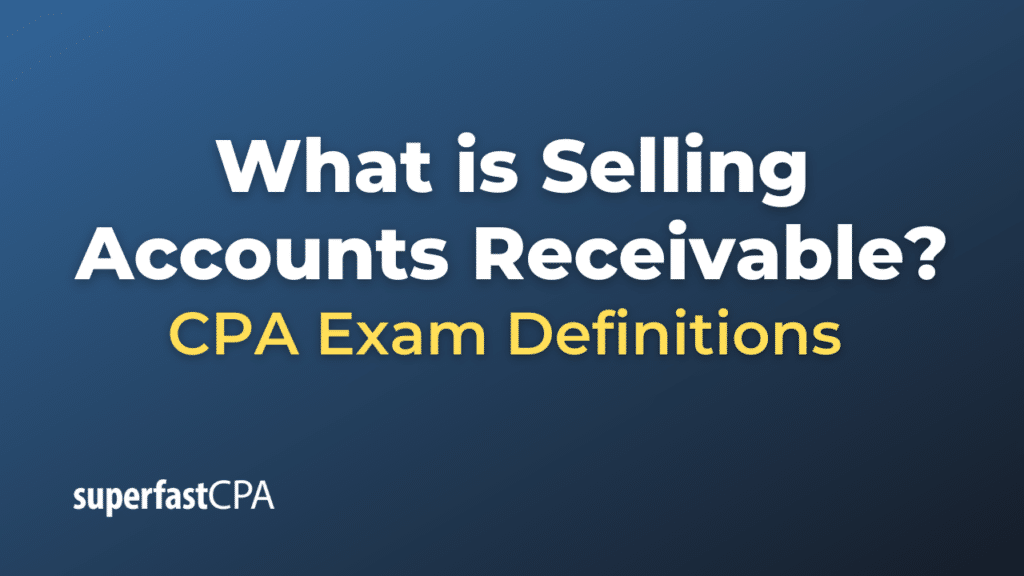Selling Accounts Receivable
Selling accounts receivable, often referred to as “factoring,” involves a business selling its outstanding invoices (accounts receivable) to a third party, called a factor, at a discount. By doing this, the business receives immediate cash, while the responsibility for collecting on those invoices is transferred to the factor.
The primary reason businesses choose to sell their accounts receivable is to improve their cash flow. Instead of waiting for customers to pay their invoices in 30, 60, or even 90 days, a company can get most of that money immediately through factoring.
Here’s a breakdown of the process:
- Agreement: The business and the factor enter into an agreement that outlines the percentage of the invoice value the business will receive upfront, the fees the factor will charge, and other terms of the relationship.
- Verification: The factor will typically verify the legitimacy and likelihood of payment of the invoices being factored.
- Advance: Once verified, the factor provides an advance to the business. This is typically a significant percentage of the invoice value but not the full amount.
- Collection: The factor takes on the responsibility of collecting the full invoice amount from the business’s customer.
- Settlement: Once the factor has successfully collected from the customer, they’ll pay the remaining balance to the original business, minus any fees or agreed-upon costs.
There are two main types of factoring:
- Recourse Factoring: If the factor cannot collect payment from the debtor, the business selling the accounts receivable must buy them back or replace them with other receivables of equal value. This form of factoring is generally less expensive since the business retains the risk of non-payment.
- Non-recourse Factoring : The factor assumes all risks of non-payment. If the factor can’t collect, they absorb the loss. Because the factor is taking on more risk, non-recourse factoring typically comes with higher fees.
Advantages of Selling Accounts Receivable:
- Immediate liquidity and improved cash flow.
- Reduction in collection overhead and efforts.
- Potential to offload credit risk (in non-recourse factoring).
Disadvantages:
- It’s more costly than traditional financing methods as businesses receive less than the full value of their receivables.
- Possible negative perceptions from customers if they prefer dealing directly with the original business instead of a third-party factor.
- Loss of control over customer relationships, especially if the factor uses aggressive collection tactics.
In summary, selling accounts receivable can be a useful tool for businesses that need to quickly convert outstanding invoices into cash, but it’s essential to weigh the costs and potential impacts on customer relationships.
Example of Selling Accounts Receivable
Let’s delve into a practical example to understand the concept of selling accounts receivable:
Scenario: Stellar Designs Inc.
Background: Stellar Designs Inc. is a small graphic design firm. They have recently completed a major project for a client and have billed the client $100,000, which is payable in 60 days. However, Stellar Designs needs cash now to meet payroll and fund a new project.
Factoring Deal: FastCash Factor Inc., a factoring company, offers to buy Stellar Designs’ $100,000 invoice.
- Agreement Terms:
- Initial Payment:
- Stellar Designs receives an initial advance: 85% of $100,000 = $85,000.
- Collection:
- FastCash Factor Inc. takes over the responsibility of collecting the $100,000 invoice from the client.
- Settlement:
- 60 days later, the client pays the full $100,000 to FastCash.
- FastCash then calculates what’s owed to Stellar Designs: $100,000 (invoice value) – $85,000 (initial payment) – $3,000 (3% fee) = $12,000.
- FastCash sends the remaining $12,000 to Stellar Designs.
Outcome: By the end of this factoring arrangement:
- Stellar Designs Inc. has received a total of $97,000 for their $100,000 invoice ($85,000 initially + $12,000 later).
- They’ve effectively paid $3,000 to get access to most of their money much faster than waiting for the client to pay.
- FastCash Factor Inc. has earned $3,000 for their services and for providing the cash upfront.
This example demonstrates the mechanics and financial implications of a typical factoring arrangement. Stellar Designs sacrificed a portion of their invoice value but gained immediate liquidity, which was crucial for their operational needs.













